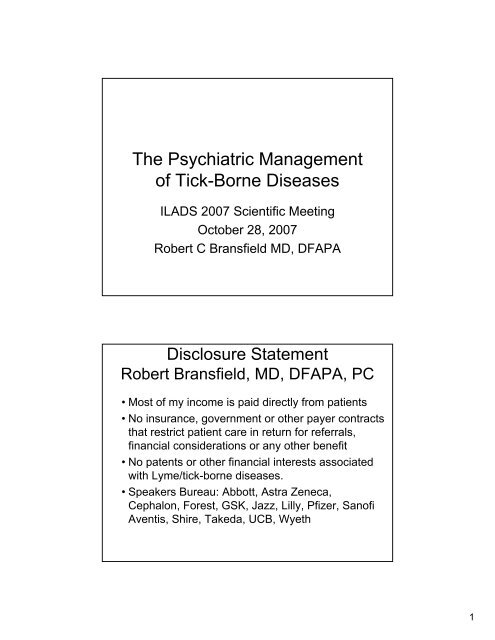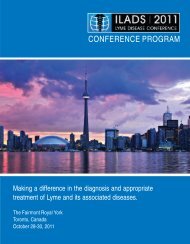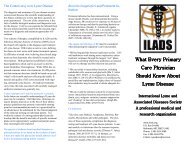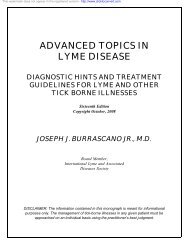The Psychiatric Management of Tick-Borne Diseases - ILADS
The Psychiatric Management of Tick-Borne Diseases - ILADS
The Psychiatric Management of Tick-Borne Diseases - ILADS
You also want an ePaper? Increase the reach of your titles
YUMPU automatically turns print PDFs into web optimized ePapers that Google loves.
<strong>The</strong> <strong>Psychiatric</strong> <strong>Management</strong><br />
<strong>of</strong> <strong>Tick</strong>-<strong>Borne</strong> <strong>Diseases</strong><br />
<strong>ILADS</strong> 2007 Scientific Meeting<br />
October 28, 2007<br />
Robert C Bransfield MD, DFAPA<br />
Disclosure Statement<br />
Robert Bransfield, MD, DFAPA, PC<br />
• Most <strong>of</strong> my income is paid directly from patients<br />
• No insurance, government or other payer contracts<br />
that restrict patient care in return for referrals,<br />
financial considerations or any other benefit<br />
• No patents or other financial interests associated<br />
with Lyme/tick-borne diseases.<br />
• Speakers Bureau: Abbott, Astra Zeneca,<br />
Cephalon, Forest, GSK, Jazz, Lilly, Pfizer, San<strong>of</strong>i<br />
Aventis, Shire, Takeda, UCB, Wyeth<br />
1
Pathopyhsiology<br />
Pathological Cascade<br />
Causes <strong>of</strong> Disease<br />
Genetic, Developmental, Proximate<br />
Pathophysiology<br />
Dysfunction<br />
Syndrome <strong>of</strong> Dysfunction<br />
Symptoms<br />
2
Disease Progression<br />
Persistence<br />
<strong>of</strong> Symptoms<br />
Ineffective<br />
Treatment<br />
Illness Progression &<br />
Treatment Resistance<br />
Understanding the Cause<br />
Over Time<br />
• Predisposing factors<br />
• Precipitating factors<br />
• Perpetuating & disease progression factors<br />
• Pathophysiology<br />
• <strong>The</strong> next step is disease modifying<br />
treatments<br />
3
Disease Contributors Change with<br />
Time<br />
Symptom<br />
“Intensity”<br />
Predisposing Factors<br />
Precipitating Factors<br />
Perpetuating Factors<br />
1 2 3 4<br />
Preclinical Onset<br />
Course<br />
Short-Term Chronic<br />
Adapted from Spielman AJ et al. Psychiatr Clin North Am. Course <strong>of</strong> Insomnia; 1987;10:541-553.<br />
Threshold<br />
Schema <strong>of</strong> Etiologic and Pathogenetic Factors That Have Been Implicated in Cell Death in<br />
Parkinson Disease and Possible Neuroprotective Approaches<br />
Copyright restrictions may apply.<br />
Schapira, A. H. V. et al.<br />
JAMA 2004;291:358-364.<br />
4
Do Psychotropics Have<br />
Antimicrobial Effects or Immune<br />
Effects?<br />
Antibiotics: <strong>The</strong> First Antidepressants<br />
• In 1952, Zeller and associates found that “MAO was<br />
inhibited by the hydrazine MAOI, iproniazid,” and Selik<strong>of</strong>f<br />
and co-workers and Bloch and colleagues fortuitously<br />
noticed mood elevation in tuberculosis patients treated<br />
with iproniazid. Crane and Kline independently studied<br />
iproniazid in depressed patients and reported favorable<br />
results. <strong>The</strong> use <strong>of</strong> iproniazid was associated with<br />
hepatic toxicity, however, and as a result, other drugs<br />
that differed in a variety <strong>of</strong> properties and structures but<br />
shared the same common property <strong>of</strong> MAO inhibition<br />
were studied.<br />
• <strong>The</strong> other hydrazines--isocarboxazid, nialamide and<br />
phenelzine in this regard and also notes that as far back<br />
as 1948.<br />
Klein DF, Gittelman R, Quikin F, Rifkin A. Diagnosis and Drug Treatment <strong>of</strong> <strong>Psychiatric</strong><br />
Disorders: Adults and Children. Second Edition. Williams & Wilkins, Baltimore. 1980<br />
[a] pp 303-306; [b] p 464; [c] p 269<br />
5
Immunomodulatory effect <strong>of</strong> SSRIs on<br />
human T lymphocyte function and gene<br />
expression<br />
• Antidepressants have an antiproliferative effect in some<br />
cell lines. Depression may be associated with activation<br />
<strong>of</strong> some pro-inflammatory cytokines.<br />
• We found that the SSRIs, paroxetine and sertraline<br />
decreased T-cell viability with IC50 around 10 μM.<br />
• <strong>The</strong>se SSRIs inhibit the secretion <strong>of</strong> the TH1 factortumor<br />
necrosis factor(TNF)α from the cells. On the<br />
molecular level, the SSRIs suppressed signal transducer<br />
and activator <strong>of</strong> transcription 3 (Stat3) and<br />
cyclooxygenase(Cox)2 protein expression.<br />
• <strong>The</strong> inhibitory effects were accompanied by alterations in<br />
gene expression as assessed in the gene array. <strong>The</strong>se<br />
findings reveal an immunomodulatory effect <strong>of</strong> the SSRIs<br />
paroxetine and sertraline in human T cells.<br />
Taler, et al. European Neuropsychopharmacology<br />
Balanced Inflammation<br />
• Inflammation could have a protective role and promote<br />
regeneration <strong>of</strong> damaged neurons. We do not yet know<br />
how to achieve a "balanced" inflammation. Because<br />
some novel anti-inflammatory treatment might have<br />
detrimental consequences, carefully monitoring disease<br />
progress in patients treated with this category <strong>of</strong> drugs is<br />
indispensable<br />
• A variety <strong>of</strong> neurological diseases the initial triggers differ<br />
significantly, while the subsequent pathways involving<br />
inflammatory processes and causing brain damage<br />
share certain pathological mechanisms<br />
Aktas, O. et al. Arch Neurol 2007;64:185-189.<br />
6
Chlamydia<br />
Chlamydiacea and Haloperidole<br />
EB= elementary body<br />
RB = reticulate body<br />
35-40h<br />
Karin D.E. Everett (2000) Vet. Microbiol. 75: 109-126<br />
Murray & Ward (1984) J. Gen. Microbiol.130:193-201<br />
Barbara Fellerh<strong>of</strong>f<br />
Institute for Immunology LMU Munich<br />
Haloperidole<br />
8h<br />
30h<br />
24h<br />
7
Metabolites <strong>of</strong> the antipsychotic agent clozapine inhibit<br />
the replication <strong>of</strong> human immunodeficiency virus type 1<br />
• Clozapine, an atypical antipsychotic, and nine <strong>of</strong><br />
its metabolites were studied in vitro for possible<br />
antiviral activity against a model <strong>of</strong> a human<br />
neurotropic virus, HIV-1.<br />
• In an assay for inhibition <strong>of</strong> virus-induced<br />
cytopathic effect two metabolites demonstrated<br />
antiviral activity.<br />
• <strong>The</strong>se data suggest that the therapeutic efficacy<br />
<strong>of</strong> some antipsychotics may be due in part to an<br />
ability to inhibit viral replication. Antiviral agents<br />
may prove to be effective adjuncts in the<br />
treatment <strong>of</strong> schizophrenia.<br />
Jones-Brando LV, Buthod JL, Holland LE, Yolken RH, Torrey EF.<br />
Schizophr Res. 1997 May 3;25(1):63-70.<br />
Psychotropics<br />
• Antidepressants were developed from TB<br />
drugs that had mood lifting side effects<br />
• Psychotropics effect neurotransmitters &:<br />
– Are sometimes antimicrobial<br />
– Can be immune modulators<br />
– May alter CNS gene expression<br />
– Can be neuroprotective<br />
– Can increase neurogenesis and BDNF<br />
8
<strong>The</strong>re Are No FDA Approved<br />
Treatments for Late Stage <strong>Tick</strong>-<br />
<strong>Borne</strong> Disease<br />
FDA Labeling Issues<br />
• 88% <strong>of</strong> the diagnostic categories in the DSM-TR do not<br />
have a FDA approved treatment [1]<br />
• “<strong>The</strong> FDA does not regulate the practice <strong>of</strong> medicine and<br />
physicians may use a drug in ways other than indicated on<br />
the labeling when, in their pr<strong>of</strong>essional judgment, it is<br />
warranted in a particular case.” [2]<br />
• “<strong>The</strong> standard <strong>of</strong> care is <strong>of</strong>ten not the same as the FDA<br />
labeling for any particular treatment. Good medical practice<br />
and the best interests <strong>of</strong> the patient require that physicians<br />
use legally available drugs, biologics and devices according<br />
to their best knowledge and judgment.” [2]<br />
• “<strong>The</strong> FDA recognizes that <strong>of</strong>f-label use <strong>of</strong> drugs by<br />
prescribers is <strong>of</strong>ten appropriate and may represent the<br />
standard <strong>of</strong> practice.” [2]<br />
[1] Nasrallah, H. Off-label prescribing: Cutting edge psychopharmacology.<br />
Current Psychiatry; Vol.6,No3, March 2007<br />
[2] FDA<br />
9
Confront Dogma<br />
Think Outside the Box<br />
10
General Considerations<br />
Neuropsychiatric Herxheimer<br />
Reaction<br />
• Treating Lyme/tick-borne disease patients with<br />
antibiotics may cause a Jarisch-Herxheimer<br />
reaction<br />
• This reaction may exacerbate any symptom<br />
caused by the infection<br />
• A sudden appearance <strong>of</strong> depression, suicide<br />
attempts, agitation & violence may be a part <strong>of</strong><br />
this reaction. “You can’t bear to live. It is<br />
beyond the imagination.”<br />
• Slowly starting the antibiotic, close observation<br />
& psychotropics are helpful<br />
11
Substance Abuse and LB/TBI<br />
• Although most LB/TBI patients realize they<br />
have a reduced tolerance to alcohol, a few<br />
abuse alcohol which exacerbates their<br />
symptoms.<br />
• Drug abuse is more common, most<br />
notably pain meds and tranquilizers.<br />
• Well planned treatments minimize these<br />
risks.<br />
Minimize Life Stress<br />
• Chronic illness decreases functioning<br />
which increases stress and contributes to<br />
perpetuating illness.<br />
• Strategies to reduce chronic stress<br />
improve recovery.<br />
12
Antibiotics or Psychotropics?<br />
• When a patient has been treated with just<br />
antibiotics, consider psychotropics.<br />
• When a patient has been treated with just<br />
psychotropics, consider antibiotics.<br />
• When a patient is treatment resistant<br />
consider both.<br />
Dosing Strategies<br />
• Change one treatment at a time<br />
• If something works, continue it<br />
• Some patients are drug sensitive and low<br />
doses are needed<br />
13
Anticipate the Unexpected Adverse<br />
Drug Reaction<br />
• Due to the complexity <strong>of</strong> the human brain<br />
and individual differences, there will<br />
always be someone with an opposite<br />
response or unusual reaction to any<br />
psychotropic.<br />
• An apparent adverse drug reaction may<br />
instead be a symptom flare or Herxheimer<br />
reaction<br />
• Be prepared to respond to the<br />
unexpected.<br />
Symptomatic Treatment<br />
14
Symptomatic Treatment Reduces<br />
Disease Progression with:<br />
• Insomnia<br />
• Attention deficit hyperactivity disorder<br />
• Anxiety disorders<br />
• Posttraumatic stress disorder<br />
• Depression<br />
• Bipolar disorder<br />
• Schizophrenia<br />
• Alzheimer’s<br />
• Other general medical conditions<br />
Benefit <strong>of</strong> Symptomatic Treatment<br />
• Chronic stress, dysregulated hyper/hypoarousal<br />
& impaired sleep cause<br />
compromised immune functioning<br />
(increased inflammation, decreased<br />
cellular immune response) & increased<br />
oxidative stress resulting in decreased<br />
neuroprotection and increased<br />
neurodegeneration<br />
• Symptomatic treatments can prevent and<br />
sometimes reverse progression <strong>of</strong> illness<br />
15
Symptom Priority<br />
• A TBD patent may have over 100 different<br />
symptoms.<br />
• After completing an assessment, prioritize<br />
which symptoms are most sever and<br />
contribute the most towards perpetuating<br />
chronic illness.<br />
• Treat the high priority symptoms first and<br />
work your way down the list.<br />
What Symptoms Perpetuate TBD<br />
Disease?<br />
• Sleep disorders<br />
• Fatigue<br />
• Cognitive impairments<br />
• Depression<br />
•Anxiety<br />
•Pain<br />
• Headaches<br />
• Others<br />
16
Variability in Sleep Patterns in a Normal Adult vs a<br />
Patient With Major Depression<br />
Normal<br />
Adult<br />
Patient With<br />
Major<br />
Depression<br />
Sleep Stage<br />
Sleep Stage<br />
Awake<br />
REM<br />
1<br />
2<br />
3<br />
4<br />
Awake<br />
REM<br />
1234<br />
Sleep<br />
Latency<br />
Sleep<br />
Cycle<br />
Total Sleep Time<br />
1 2 3 4 5 6 7 8<br />
Time (h)<br />
1 2 3 4<br />
Time (h)<br />
5 6 7 8<br />
Adapted with permission from Winokur A, Reynolds CF III. Primary Psychiatry. Nov/Dec 1994:22-27.<br />
Please see important safety information on accompanying slides and full prescribing information.<br />
17
Bidirectional Communication between the Brain and the<br />
Immune System: Implications for Physiological Sleep<br />
and Disorders with Disrupted Sleep<br />
• Cytokines produced by cells <strong>of</strong> the immune<br />
and nervous systems regulate sleep.<br />
• particularly interleukin-1beta and tumor<br />
necrosis factor-alpha, signal neuroendocrine,<br />
autonomic, limbic and cortical areas <strong>of</strong> the CNS<br />
to affect neural activity and modify behaviors<br />
(including sleep), hormone release and<br />
autonomic function.<br />
• Sleep disorders are commonly associated with<br />
chronic inflammatory diseases and chronic ageor<br />
stress-related disorders. <strong>The</strong> best studied are<br />
rheumatoid arthritis, fibromyalgia and chronic<br />
fatigue syndromes.<br />
Lorton D et al. Neuroimmunomodulation. 2006;13(5-6):357-74. Epub 2007 Aug 6.<br />
Sleep restriction increases IL-6 and<br />
pain-related symptoms in healthy<br />
volunteers<br />
• Chronic under-sleeping may contribute to<br />
the high prevalence <strong>of</strong> pain experiences<br />
observed in the general population<br />
• Chronic sleep restriction leads to mild<br />
elevations in IL-6, an important inflammatory<br />
modulator, and may contribute to the sleep<br />
loss-pain relationship we observed in the<br />
present study<br />
M. Haack, E. Sanchez, J. Broussard, M. Regan, J. Mullington<br />
J Pain; April 2004, Supplement 1 • Volume 5 • Number 3<br />
18
Possible Functions <strong>of</strong> Slow Wave<br />
Sleep<br />
• Restoration and recovery 1<br />
– SWS rebound following sleep deprivation<br />
– Growth hormone secretion during SWS<br />
– Selective SWS deprivation in animals ⇒ physical<br />
injury and death<br />
– Relationship between ⇓ SWS, aging, and sleep/wake<br />
complaints<br />
• Energy conservation 2<br />
– ⇑ SWS during hibernation<br />
– ⇓ Core body temperature and metabolic rate during<br />
SWS<br />
• Predator avoidance 2<br />
1. Kryger MH et al. In: Kryger MH, Roth T, Dement WC, eds. Principles and Practice <strong>of</strong> Sleep Medicine. 2 nd ed.<br />
Philadelphia, PA. W.B. Saunders 1994: 301-308.<br />
2. Zepelin H. In: Kryger MH, Roth T, Dement WC, eds. Principles and Practice <strong>of</strong> Sleep Medicine. 2 nd ed.<br />
Philadelphia, PA: W.B. Saunders 1994: 69-80.<br />
Impaired Sleep Correlates with<br />
Impaired Immune Functioning<br />
• Sleep and the immune system. Int J Immunopharmacol<br />
1995;17:649-54.<br />
• Disordered sleep in fibromyalgia and related my<strong>of</strong>ascial<br />
facial pain conditions. Dent Clin North Am<br />
2001;45:701-13.<br />
• <strong>Management</strong> <strong>of</strong> sleep disorders in fibromyalgia.<br />
Rheum Dis Clin North Am. 2002;28:353-65.<br />
• Sleep, neuroimmune and neuroendocrine functions in<br />
fibromyalgia and chronic fatigue syndrome.<br />
Adv Neuroimmunol 1995;5:39-56.<br />
• Fibromyalgia, sleep disorder and chronic fatigue<br />
syndrome. Ciba Found Symp 1993;173:262-79. H. Mold<strong>of</strong>sky<br />
19
Normalizing the Amplitude <strong>of</strong> the<br />
Circadian Rhythm<br />
• Activating agent in the morning<br />
• Sleep promoting agent at night<br />
• Combination <strong>of</strong> both<br />
Normalizing the Amplitude<br />
<strong>of</strong> Circadian Rhythm<br />
Activating Agents (AM)<br />
• Modafinil<br />
• Stimulants<br />
• Bupropion<br />
• Noradrenergic agents<br />
• SSRIs<br />
• Activating atypicals<br />
• Thyroid<br />
Sleep Promoting (PM)<br />
• Pregabalin, Tigabine<br />
• Trazodone, Quintiapine<br />
• Sodium Oxybate<br />
• Gabapentin<br />
• Non-Benzos: Zolpiderm,<br />
Zaleplon, Zopiclone<br />
• Benzodiazepines<br />
• Doxepin, Amitriptyline, etc.<br />
• Mirtazapine<br />
• Antihistamines<br />
• Sedating atypicals<br />
• Melatonin, Ramelton<br />
20
Potential Uses <strong>of</strong> Modafinil in<br />
<strong>Psychiatric</strong> Disorders*<br />
• Modafinil was administered as part <strong>of</strong> a treatment<br />
regimen in patients (N=237) with a broad spectrum<br />
<strong>of</strong> treatment-resistant psychiatric, neurological and<br />
general medical disorders accompanied by some<br />
combination <strong>of</strong> excessive sleepiness, fatigue,<br />
executive dysfunction and apathy.<br />
• In a retrospective chart review with CGI-S, 84.4%<br />
improved and most tolerated the agent well<br />
• Modafinil may <strong>of</strong>fer clinical benefit for treatmentresistant<br />
hypoarousal symptoms in a number <strong>of</strong><br />
psychiatric, neurological and general medical<br />
conditions.<br />
*Bransfield RC. <strong>The</strong> Journal <strong>of</strong> Applied Research. Vol.4, No. 2, 2004<br />
21
Nociceptive vs Neuropathic Pain States<br />
Nociceptive Neuropathic<br />
• Arises from stimulus outside<br />
<strong>of</strong> nervous system<br />
• Proportionate to receptor<br />
stimulation<br />
• When acute, serves<br />
protective function<br />
Serra. Acta Neurol Scand. 1999;173(suppl):7<br />
1999;173(suppl):7-11<br />
11.<br />
Examples <strong>of</strong> Nociceptive and<br />
Neuropathic Pain<br />
vs<br />
Nociceptive Mixed<br />
Caused by<br />
tissue damage<br />
• Arthritis<br />
• Mechanical low<br />
back pain<br />
• Sports/exercise injuries<br />
• Postoperative pain<br />
Caused by<br />
combination<br />
<strong>of</strong> primary<br />
injury and<br />
secondary<br />
effects<br />
• Low back pain<br />
• Fibromyalgia<br />
• Neck pain<br />
• Cancer pain<br />
• Arises from primary lesion<br />
or dysfunction in nervous<br />
system<br />
• No nociceptive stimulation<br />
required<br />
• Disproportionate to<br />
receptor stimulation<br />
• Other evidence <strong>of</strong> nerve<br />
damage<br />
Neuropathic<br />
Caused by<br />
lesion or dysfunction<br />
in the nervous system<br />
• Painful DPN<br />
• PHN<br />
• Neuropathic low back pain<br />
• Trigeminal neuralgia<br />
• Central poststroke pain<br />
• Complex regional pain syndrome<br />
• Distal HIV polyneuropathy<br />
22
Sodium Oxybate: CNS<br />
Pharmacology<br />
• Binds to GABA B receptor<br />
– May play important role in pharmacologic<br />
activity at therapeutic dosage levels<br />
– Antagonism <strong>of</strong> GABAB in animal models<br />
inhibits sodium oxybate–induced sleep and<br />
some neuromodulation effects<br />
• Metabolic effects<br />
– Decreases cerebral glucose utilization<br />
– Cerebral protective effects<br />
Sodium Oxybate:<br />
Open-Label Dose-Escalation Trial—<br />
Effect on Stage 3 and 4 Sleep<br />
Total stage 3 and 4 sleep<br />
(min)<br />
30<br />
25<br />
20<br />
15<br />
10<br />
5<br />
0<br />
Baseline<br />
N=21.<br />
*P=0.012.<br />
Stimulant medications maintained.<br />
Black et al. Sleep. 2001;23(suppl 2):A321.<br />
4.5<br />
(1st dose)<br />
4.5<br />
(wk 0-4)<br />
6.0<br />
(wk 4-6)<br />
Sodium oxybate dose (g)<br />
7.5<br />
(wk 6-8)<br />
*<br />
9.0<br />
(wk 8-10)<br />
23
Increase in NREM Sleep Duration<br />
Sodium Oxybate-Modafinil: 8-Week, Placebo-Controlled<br />
Trial<br />
Median change<br />
from baseline (min)<br />
50<br />
40<br />
30<br />
20<br />
10<br />
0<br />
-10<br />
Baseline (min):<br />
Change from baseline (modafinil)<br />
Placebo<br />
(modafinil<br />
withdrawn)<br />
Modafinil<br />
(unchanged<br />
dosing)<br />
Sodium<br />
oxybate<br />
Modafinil +<br />
sodium<br />
oxybate<br />
327 333 340 324<br />
NREM = non-REM. N=222. SXB-22. P values compared with placebo.<br />
Data on file, Orphan Medical.<br />
Sleep<br />
–<br />
P
Sleep<br />
Administered at Night: Sodium<br />
Oxybate Stabilizes Nocturnal Sleep<br />
GABA<br />
(ventrolateral<br />
Preoptic<br />
area)<br />
–<br />
At night<br />
Norepinephrine<br />
Serotonin<br />
GABA<br />
–<br />
Sodium<br />
oxybate<br />
–<br />
GABAB receptor<br />
Norepinephrine<br />
Histamine<br />
Dopamine<br />
Wake<br />
Serotonin<br />
Acetylcholine<br />
Memantine (Namenda)<br />
• Memantine is FDA approved for moderate to<br />
severe Alzheimer’s disease.<br />
• It is similar to the antiviral, amantadine, and was<br />
used to treat AIDS. Although ineffective for AIDS, it<br />
was effective for AIDS dementia.<br />
• Memantine is considered to be neuroprotective as<br />
a NMDA partial antagonist by selectively block the<br />
excitotoxic effects associated with abnormal<br />
transmission <strong>of</strong> glutamate, while allowing for the<br />
physiological transmission associated with normal<br />
cell functioning.<br />
• Quinolinic acid is increased in infectious and other<br />
neurodegenerative encephalopathies.<br />
• Quinolinic acid is neurotoxic as an NMDA agonist.<br />
25
Memantine Mechanism <strong>of</strong> Action<br />
• Low to moderate affinity, uncompetitive<br />
NMDA-receptor antagonist, voltagedependent,<br />
fast blocking/unblocking<br />
kinetics<br />
– Blocks the effects <strong>of</strong> abnormal glutamate<br />
activity that may lead to neuronal cell<br />
damage/loss and cognitive dysfunction<br />
– Preserves physiological activation <strong>of</strong> NMDA<br />
receptor required for learning<br />
and memory<br />
Source: Danysz W, et al. Neurotoxicity Res. 2000;2:85-87.<br />
Feedback from Lyme Patients:<br />
Memantine (Namenda)<br />
• “Without it I do less word inventions”<br />
• “Better word retrieval when I speak”<br />
• “Helps word finding problem”<br />
• “It reduces the static, crackle in the head”<br />
• “better verbal comprehension”<br />
• “More focused”<br />
26
Mood Stabilization & Aggression &<br />
Seizure Control<br />
• Anticonvulsant mood stabilizers<br />
– Valproate (Depakote ER)<br />
– Lamotrigine (Lamictal)<br />
– Pregabalin (Lyrica)<br />
– Carbemazepine (Equetro, Tegretol)<br />
– Oxcarbazepine (Trileptal)<br />
• Atypical agents<br />
– Olanzapine (Zyprexa)<br />
– Quintiapine (Seroquel)<br />
– Aripiprazole (Abilify)<br />
– Ziprasidone (Geodon)<br />
• Lithium (Lithobid, etc.)<br />
Valproate (Depakote ER)<br />
• Best treatment for aggression<br />
• Mood stabilizer<br />
• Antidepressant for some<br />
• Anti-migraine<br />
• Reduces neuropathic pain<br />
• Generally Depakote ER has less side<br />
effects<br />
27
Lamotrigine (Lamictal)<br />
• Highly effective antidepressant without<br />
sexual side effects, weight gain or<br />
significant cognitive impairments<br />
• Limited anti-mania effects<br />
• Beneficial to some with depersonalization<br />
and borderline personality<br />
• Anticonvulsant<br />
• Treats neuropathic pain and migraine<br />
• 1:1000 risk <strong>of</strong> Stevens Johnson Syndrome<br />
Pregabalin (Lyrica)<br />
• Initially approved for the treatment <strong>of</strong> central<br />
nervous system disorders, including epilepsy,<br />
diabetic neuropathy and post herpetic neuralgia.<br />
• Recently FDA approved for fibromyalgia.<br />
• Studies demonstrate efficacy for generalized<br />
anxiety and sleep disorders.<br />
• Not a mood stabilizer.<br />
28
Carbemazepine (Equetro, Tegretol)<br />
• Mood stabilizer<br />
• Can reduce aggression<br />
• Proven to reduce sound sensitivity in<br />
Lyme patients (Nields)<br />
• Equetro has less side effects<br />
Oxcarbazepine (Trileptal)<br />
• Mood stabilizer<br />
• Metabolite <strong>of</strong> carbemazipine (Tegretol)<br />
• Sometimes causes hyponatremia<br />
29
Olanzapine (Zyprexa)<br />
• Mood stabilizer, reduces mania, reduces<br />
agitation, antidepressant, reduces<br />
aggression<br />
• Cognitive benefit<br />
• Quite effective for adults with LYD/TBD<br />
• Weight gain and metabolic issues in some<br />
Quintiapine (Seroquel)<br />
• Promotes delta sleep<br />
• More commonly given at bedtime<br />
• Weight gain, but less than olanzapine<br />
(Zyprexa)<br />
30
Aripiprazole (Abilify)<br />
• Minimal weight gain<br />
• Akathesia is common causing a feeling <strong>of</strong><br />
restlessness<br />
• Anti-cholinergics <strong>of</strong>ten needed for<br />
akathesia<br />
Ziprasidone (Geodon)<br />
• Mood stabilizer and antidepressant<br />
• Can reduce acute suicidal urges in some<br />
• Twice a day or three times a day dosing<br />
needed<br />
• Less weight gain but more EPS than other<br />
atypicals<br />
• Anti-cholinergics <strong>of</strong>ten needed<br />
31
Benzodiazepines<br />
• Useful for acute anxiety, but tolerance and<br />
dependence can occur<br />
• May disrupt sleep architecture<br />
Serotonin Norepinephrine Uptake<br />
Inhibitors<br />
• Duoxetine<br />
• Venlafaxine ER, (& Venlafaxine)<br />
• Milnacipran (investigational)<br />
• Tricyclics<br />
32
Duloxetine (Cymbalta)<br />
• SNRI FDA approved for treatment <strong>of</strong><br />
depression, generalized anxiety & diabetic<br />
neuropathy<br />
• Effective for chronic pain and somatic pain<br />
symptoms, including fibromyalgia[1]<br />
• Beneficial for anxiety<br />
[1]"A Double-Blind, Multicenter Trial Comparing Duloxetine With Placebo in the Treatment <strong>of</strong> Fibromyalgia Patients With or Without<br />
Major Depressive Disorder," Lesley M. Arnold, Yili Lu, Leslie J. Cr<strong>of</strong>ford, Madelaine Wohlreich, Michael J. Detke, Smriti Iyengar,<br />
and David J. Goldstein, for the Duloxetine Fibromyalgia Trial Group, Arthritis & Rheumatism, September 2004; 50:9; pp. 2974-2984.<br />
Milnacipran<br />
• SNRI under research by Forest Labs for<br />
depression and fibromyalgia<br />
• Similarities to other SNRIs<br />
– Duloxetine (Cymbalta)<br />
– Venlafaxine (Effexor XR)<br />
33
Doxepin<br />
• Low doses are very helpful for irritable gut<br />
(reflux and irritable bowel)<br />
• Also helps sleep<br />
• Antidepressant and anti-anxiety at higher<br />
doses<br />
• Weight gain<br />
SSRIs, SNRIs<br />
• Effective for depression and a spectrum <strong>of</strong><br />
anxiety disorders<br />
• Significant individual differences in benefit<br />
and tolerability<br />
34
Acetylcholine Esterase Inhibitors<br />
• Helpful for long term memory impairments<br />
in late stage disease<br />
– Donepezil (Aricept)<br />
– Rivastigmine (Exelon)<br />
– Galantamine (Razadyne, Razadyne ER,<br />
Reminyl)<br />
Sibutramine (Meridia)<br />
• Norepinephrine, Serotonin & Dopamine<br />
Reuptake Inhibitor<br />
• FDA approved for weight loss Schedule IV<br />
• Effective for CFS, Fibro, Tourette’s, PTSD,<br />
Autism, RSD, Cerebral Palsy in research by<br />
Peter Mueller, MD in Princeton, NJ<br />
35
Conclusion<br />
• Psychotropic interventions are a critical<br />
component <strong>of</strong> a comprehensive treatment<br />
approach.<br />
• Since microbes interact with the immune and<br />
nervous systems, greater interaction is<br />
needed between specialists to more<br />
effectively treat these conditions.<br />
Can We Make a Difference?<br />
36






